Water & Sewerage Department: Sustainable Performance Report
VerifiedAdded on 2023/06/10
|22
|5438
|73
Report
AI Summary
This report evaluates the Water & Sewerage Department (WSD) in the British Virgin Islands, assessing the extent to which its structure, culture, and leadership promote long-term sustainable performance. The report highlights issues such as imbalanced organizational culture, including poor communication, conflicts of interest, and lack of employee development, alongside leadership styles that hinder employee involvement and decision-making. It analyzes these issues using organizational culture theories, such as Schein’s model, and leadership theories, including autocratic and bureaucratic styles. The report discusses the impact of these factors on employee morale and overall performance. It provides recommendations for fostering sustainable performance, considering factors like structure, culture, and leadership, aiming to ensure the organization’s survival and prosperity in a global knowledge economy. The report emphasizes the need for improved communication, employee development, and more inclusive leadership practices to enhance the WSD's long-term viability.
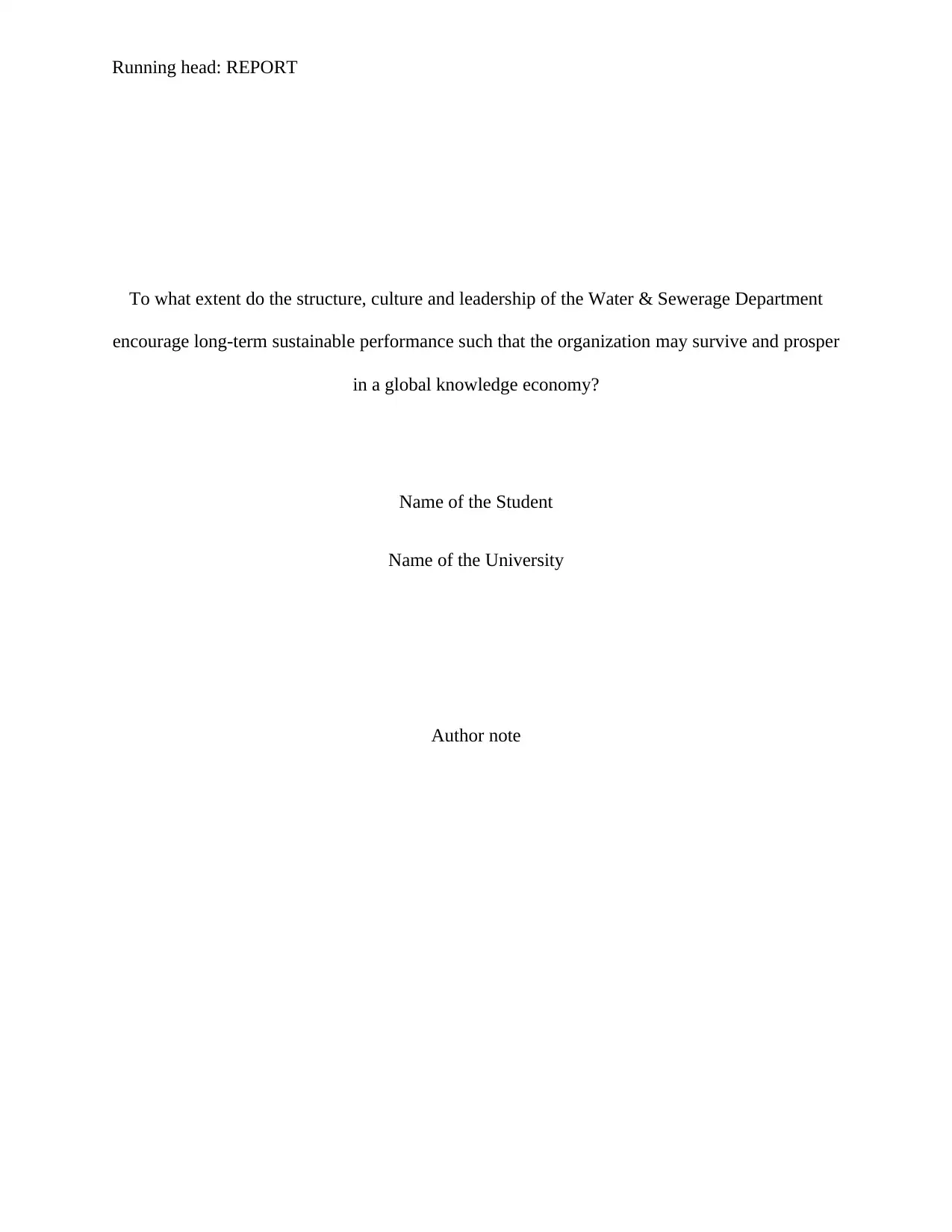
Running head: REPORT
To what extent do the structure, culture and leadership of the Water & Sewerage Department
encourage long-term sustainable performance such that the organization may survive and prosper
in a global knowledge economy?
Name of the Student
Name of the University
Author note
To what extent do the structure, culture and leadership of the Water & Sewerage Department
encourage long-term sustainable performance such that the organization may survive and prosper
in a global knowledge economy?
Name of the Student
Name of the University
Author note
Paraphrase This Document
Need a fresh take? Get an instant paraphrase of this document with our AI Paraphraser
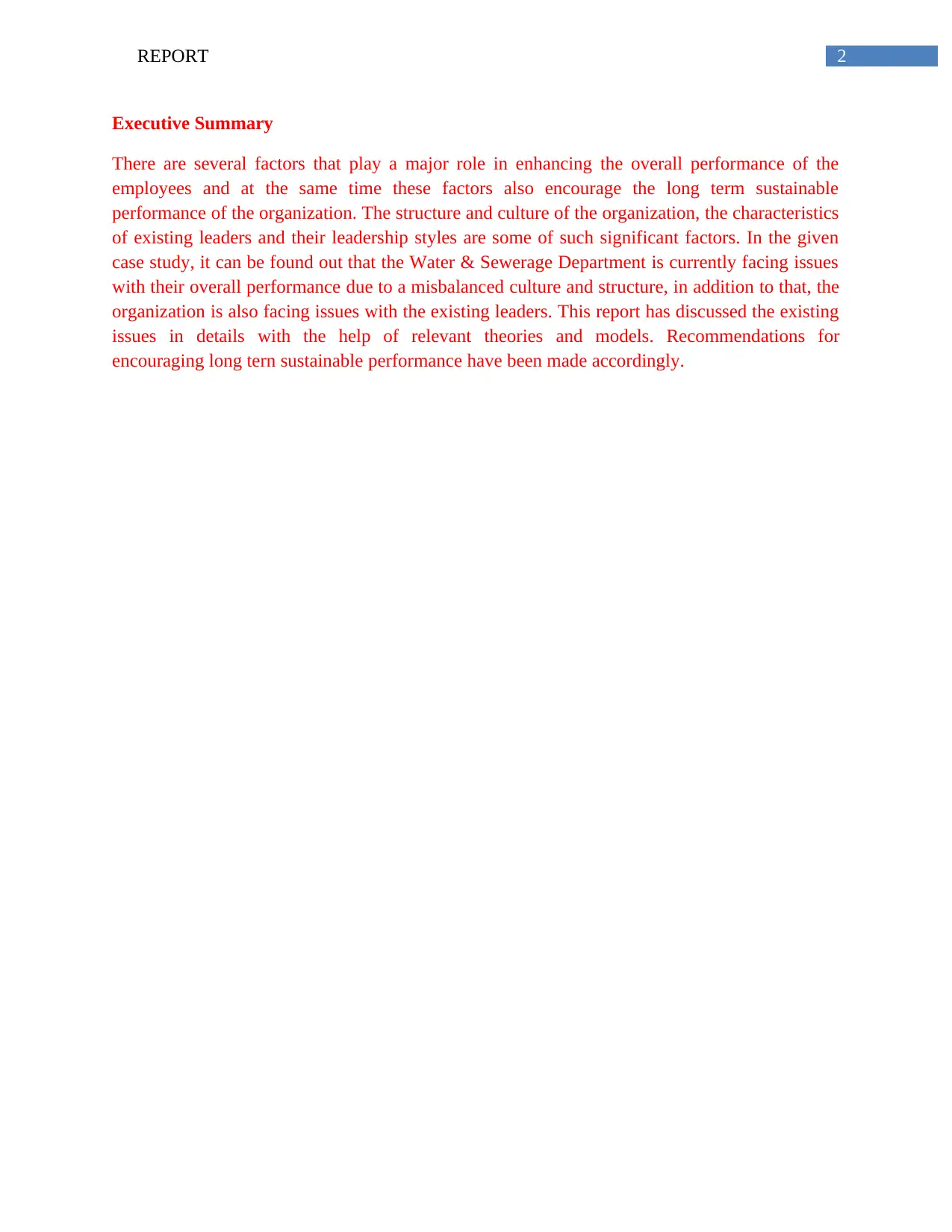
2REPORT
Executive Summary
There are several factors that play a major role in enhancing the overall performance of the
employees and at the same time these factors also encourage the long term sustainable
performance of the organization. The structure and culture of the organization, the characteristics
of existing leaders and their leadership styles are some of such significant factors. In the given
case study, it can be found out that the Water & Sewerage Department is currently facing issues
with their overall performance due to a misbalanced culture and structure, in addition to that, the
organization is also facing issues with the existing leaders. This report has discussed the existing
issues in details with the help of relevant theories and models. Recommendations for
encouraging long tern sustainable performance have been made accordingly.
Executive Summary
There are several factors that play a major role in enhancing the overall performance of the
employees and at the same time these factors also encourage the long term sustainable
performance of the organization. The structure and culture of the organization, the characteristics
of existing leaders and their leadership styles are some of such significant factors. In the given
case study, it can be found out that the Water & Sewerage Department is currently facing issues
with their overall performance due to a misbalanced culture and structure, in addition to that, the
organization is also facing issues with the existing leaders. This report has discussed the existing
issues in details with the help of relevant theories and models. Recommendations for
encouraging long tern sustainable performance have been made accordingly.
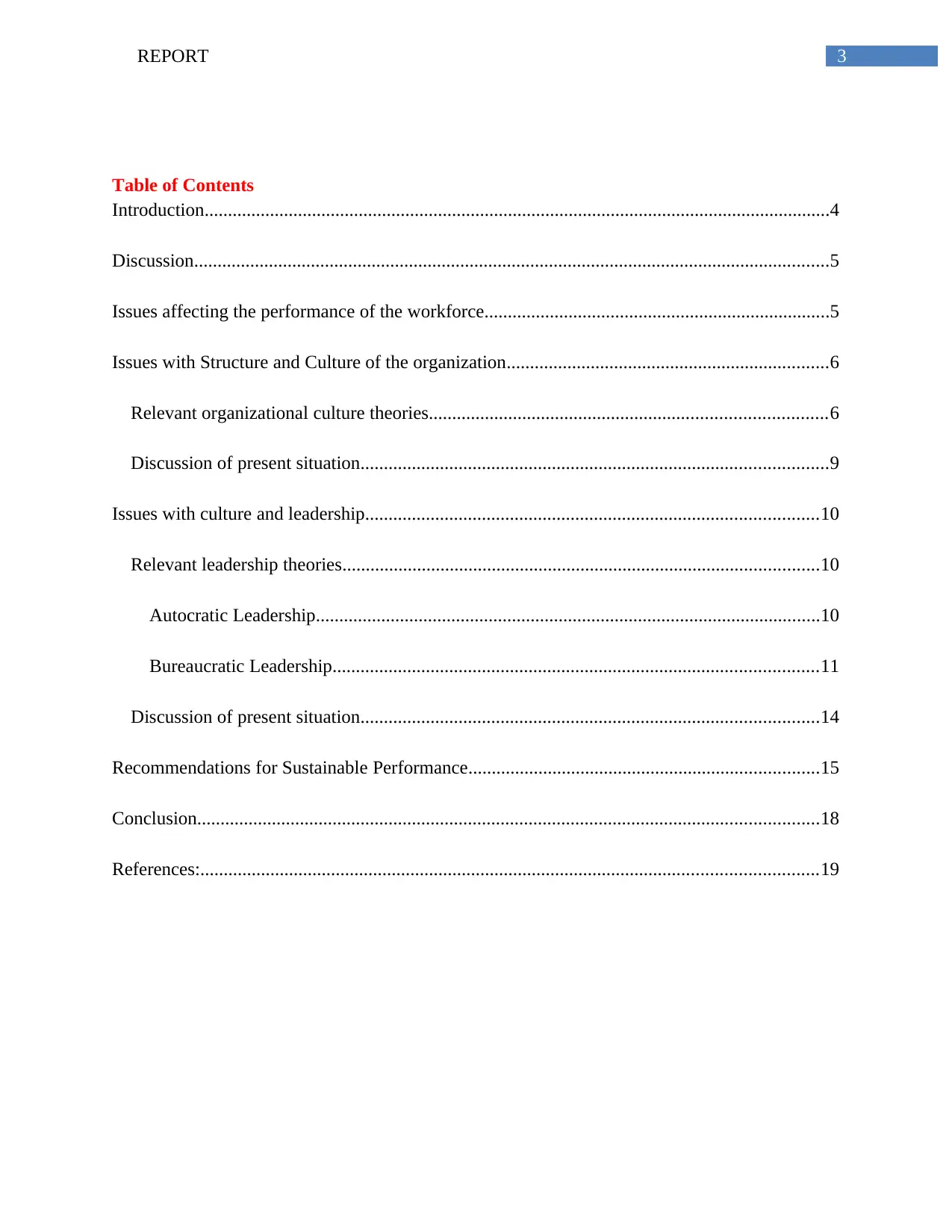
3REPORT
Table of Contents
Introduction......................................................................................................................................4
Discussion........................................................................................................................................5
Issues affecting the performance of the workforce..........................................................................5
Issues with Structure and Culture of the organization.....................................................................6
Relevant organizational culture theories.....................................................................................6
Discussion of present situation....................................................................................................9
Issues with culture and leadership.................................................................................................10
Relevant leadership theories......................................................................................................10
Autocratic Leadership............................................................................................................10
Bureaucratic Leadership........................................................................................................11
Discussion of present situation..................................................................................................14
Recommendations for Sustainable Performance...........................................................................15
Conclusion.....................................................................................................................................18
References:....................................................................................................................................19
Table of Contents
Introduction......................................................................................................................................4
Discussion........................................................................................................................................5
Issues affecting the performance of the workforce..........................................................................5
Issues with Structure and Culture of the organization.....................................................................6
Relevant organizational culture theories.....................................................................................6
Discussion of present situation....................................................................................................9
Issues with culture and leadership.................................................................................................10
Relevant leadership theories......................................................................................................10
Autocratic Leadership............................................................................................................10
Bureaucratic Leadership........................................................................................................11
Discussion of present situation..................................................................................................14
Recommendations for Sustainable Performance...........................................................................15
Conclusion.....................................................................................................................................18
References:....................................................................................................................................19
⊘ This is a preview!⊘
Do you want full access?
Subscribe today to unlock all pages.

Trusted by 1+ million students worldwide
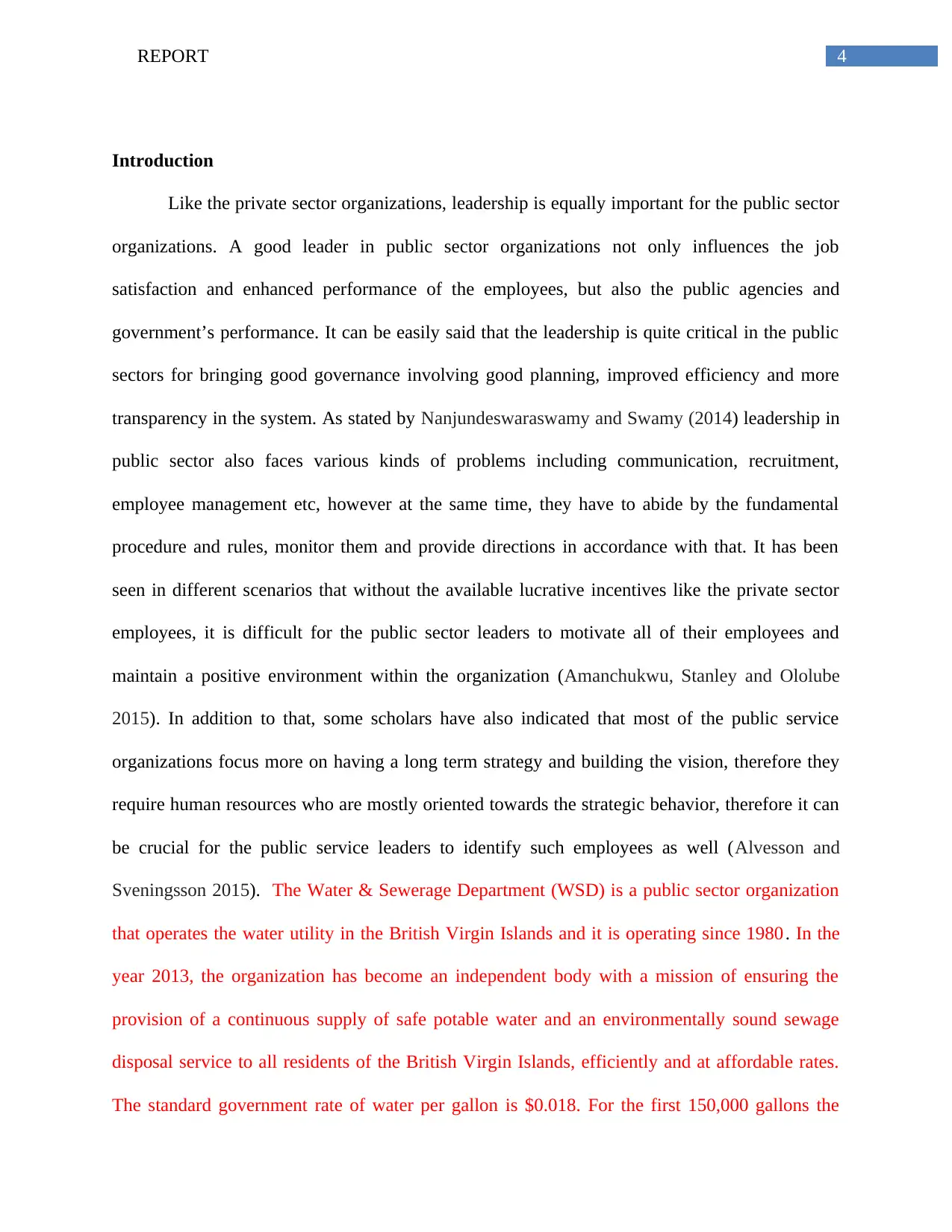
4REPORT
Introduction
Like the private sector organizations, leadership is equally important for the public sector
organizations. A good leader in public sector organizations not only influences the job
satisfaction and enhanced performance of the employees, but also the public agencies and
government’s performance. It can be easily said that the leadership is quite critical in the public
sectors for bringing good governance involving good planning, improved efficiency and more
transparency in the system. As stated by Nanjundeswaraswamy and Swamy (2014) leadership in
public sector also faces various kinds of problems including communication, recruitment,
employee management etc, however at the same time, they have to abide by the fundamental
procedure and rules, monitor them and provide directions in accordance with that. It has been
seen in different scenarios that without the available lucrative incentives like the private sector
employees, it is difficult for the public sector leaders to motivate all of their employees and
maintain a positive environment within the organization (Amanchukwu, Stanley and Ololube
2015). In addition to that, some scholars have also indicated that most of the public service
organizations focus more on having a long term strategy and building the vision, therefore they
require human resources who are mostly oriented towards the strategic behavior, therefore it can
be crucial for the public service leaders to identify such employees as well (Alvesson and
Sveningsson 2015). The Water & Sewerage Department (WSD) is a public sector organization
that operates the water utility in the British Virgin Islands and it is operating since 1980. In the
year 2013, the organization has become an independent body with a mission of ensuring the
provision of a continuous supply of safe potable water and an environmentally sound sewage
disposal service to all residents of the British Virgin Islands, efficiently and at affordable rates.
The standard government rate of water per gallon is $0.018. For the first 150,000 gallons the
Introduction
Like the private sector organizations, leadership is equally important for the public sector
organizations. A good leader in public sector organizations not only influences the job
satisfaction and enhanced performance of the employees, but also the public agencies and
government’s performance. It can be easily said that the leadership is quite critical in the public
sectors for bringing good governance involving good planning, improved efficiency and more
transparency in the system. As stated by Nanjundeswaraswamy and Swamy (2014) leadership in
public sector also faces various kinds of problems including communication, recruitment,
employee management etc, however at the same time, they have to abide by the fundamental
procedure and rules, monitor them and provide directions in accordance with that. It has been
seen in different scenarios that without the available lucrative incentives like the private sector
employees, it is difficult for the public sector leaders to motivate all of their employees and
maintain a positive environment within the organization (Amanchukwu, Stanley and Ololube
2015). In addition to that, some scholars have also indicated that most of the public service
organizations focus more on having a long term strategy and building the vision, therefore they
require human resources who are mostly oriented towards the strategic behavior, therefore it can
be crucial for the public service leaders to identify such employees as well (Alvesson and
Sveningsson 2015). The Water & Sewerage Department (WSD) is a public sector organization
that operates the water utility in the British Virgin Islands and it is operating since 1980. In the
year 2013, the organization has become an independent body with a mission of ensuring the
provision of a continuous supply of safe potable water and an environmentally sound sewage
disposal service to all residents of the British Virgin Islands, efficiently and at affordable rates.
The standard government rate of water per gallon is $0.018. For the first 150,000 gallons the
Paraphrase This Document
Need a fresh take? Get an instant paraphrase of this document with our AI Paraphraser
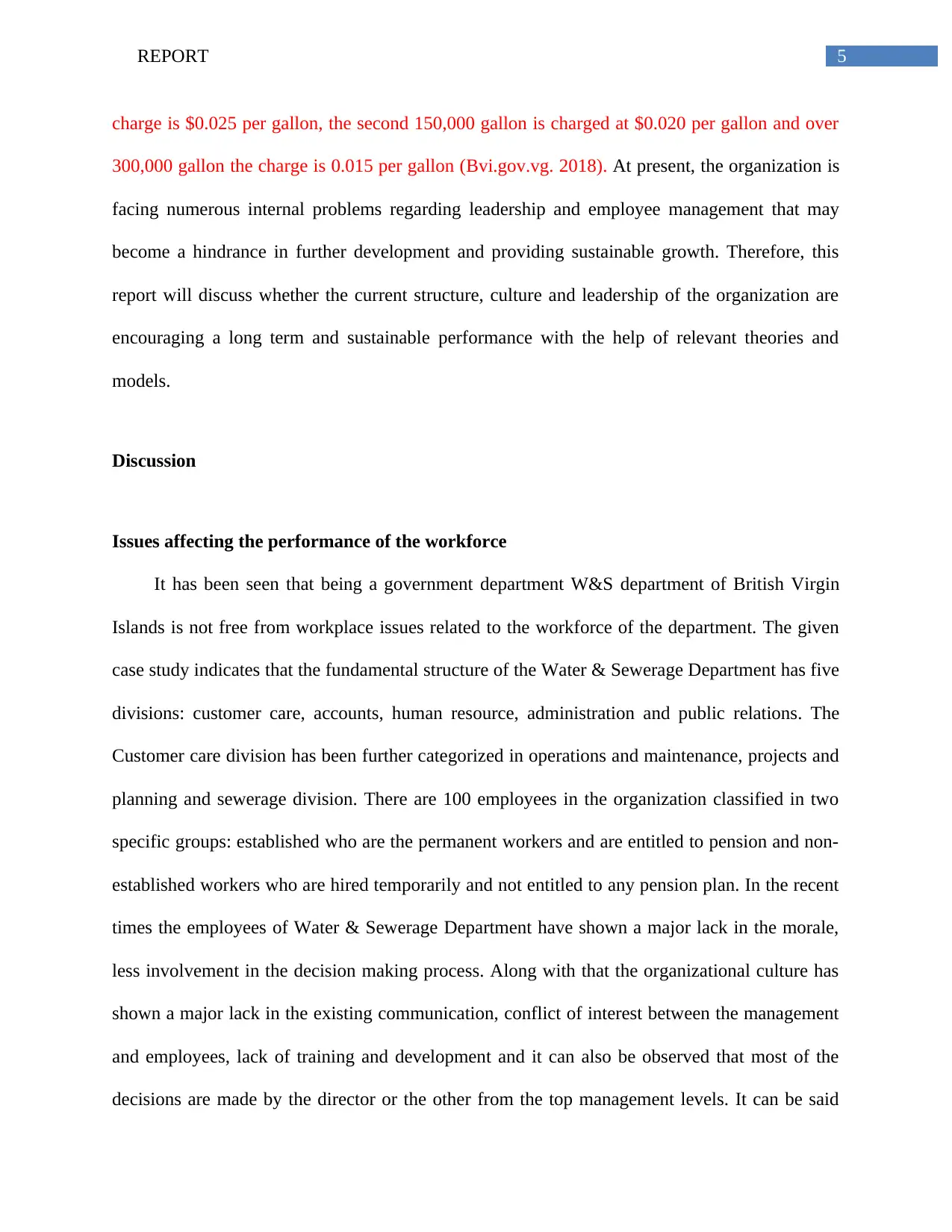
5REPORT
charge is $0.025 per gallon, the second 150,000 gallon is charged at $0.020 per gallon and over
300,000 gallon the charge is 0.015 per gallon (Bvi.gov.vg. 2018). At present, the organization is
facing numerous internal problems regarding leadership and employee management that may
become a hindrance in further development and providing sustainable growth. Therefore, this
report will discuss whether the current structure, culture and leadership of the organization are
encouraging a long term and sustainable performance with the help of relevant theories and
models.
Discussion
Issues affecting the performance of the workforce
It has been seen that being a government department W&S department of British Virgin
Islands is not free from workplace issues related to the workforce of the department. The given
case study indicates that the fundamental structure of the Water & Sewerage Department has five
divisions: customer care, accounts, human resource, administration and public relations. The
Customer care division has been further categorized in operations and maintenance, projects and
planning and sewerage division. There are 100 employees in the organization classified in two
specific groups: established who are the permanent workers and are entitled to pension and non-
established workers who are hired temporarily and not entitled to any pension plan. In the recent
times the employees of Water & Sewerage Department have shown a major lack in the morale,
less involvement in the decision making process. Along with that the organizational culture has
shown a major lack in the existing communication, conflict of interest between the management
and employees, lack of training and development and it can also be observed that most of the
decisions are made by the director or the other from the top management levels. It can be said
charge is $0.025 per gallon, the second 150,000 gallon is charged at $0.020 per gallon and over
300,000 gallon the charge is 0.015 per gallon (Bvi.gov.vg. 2018). At present, the organization is
facing numerous internal problems regarding leadership and employee management that may
become a hindrance in further development and providing sustainable growth. Therefore, this
report will discuss whether the current structure, culture and leadership of the organization are
encouraging a long term and sustainable performance with the help of relevant theories and
models.
Discussion
Issues affecting the performance of the workforce
It has been seen that being a government department W&S department of British Virgin
Islands is not free from workplace issues related to the workforce of the department. The given
case study indicates that the fundamental structure of the Water & Sewerage Department has five
divisions: customer care, accounts, human resource, administration and public relations. The
Customer care division has been further categorized in operations and maintenance, projects and
planning and sewerage division. There are 100 employees in the organization classified in two
specific groups: established who are the permanent workers and are entitled to pension and non-
established workers who are hired temporarily and not entitled to any pension plan. In the recent
times the employees of Water & Sewerage Department have shown a major lack in the morale,
less involvement in the decision making process. Along with that the organizational culture has
shown a major lack in the existing communication, conflict of interest between the management
and employees, lack of training and development and it can also be observed that most of the
decisions are made by the director or the other from the top management levels. It can be said
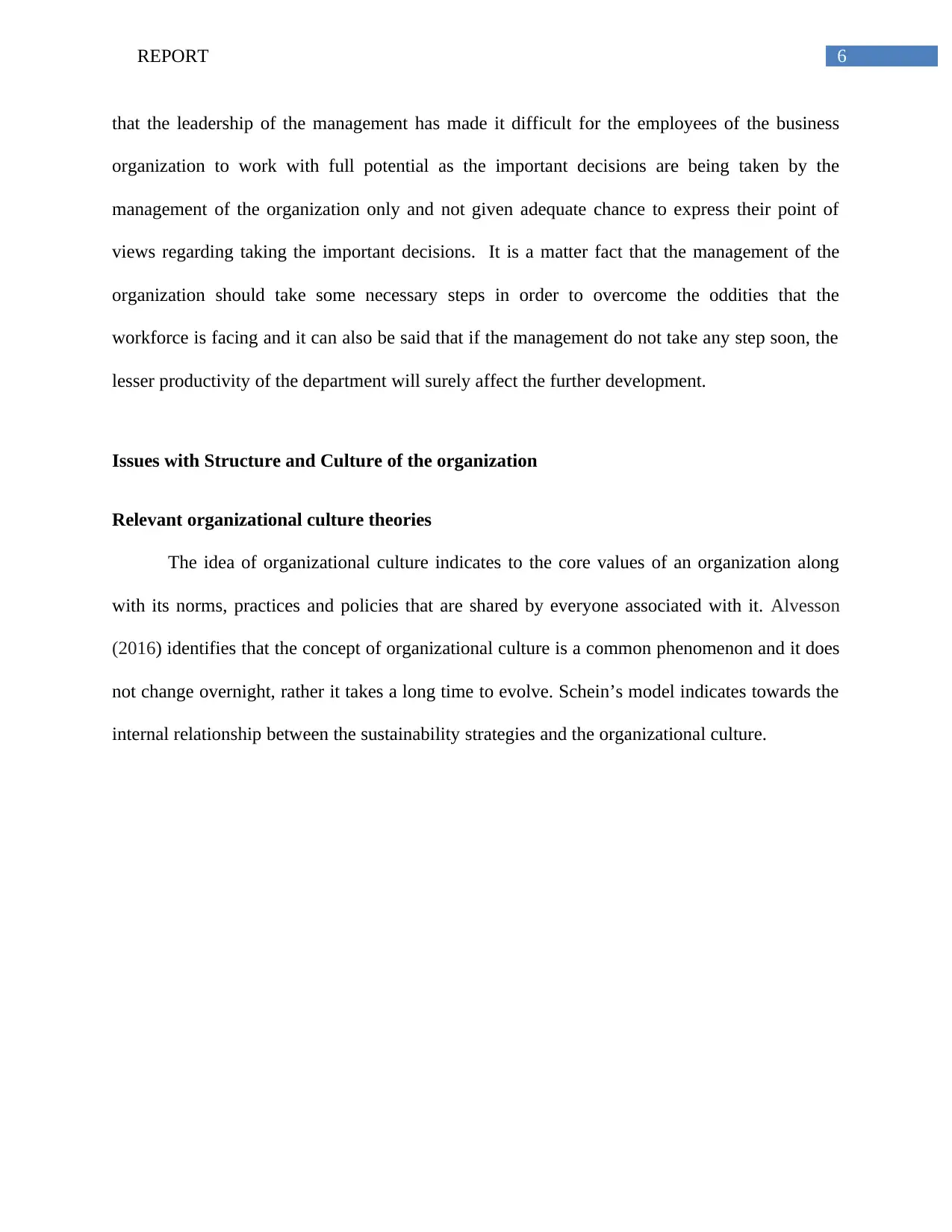
6REPORT
that the leadership of the management has made it difficult for the employees of the business
organization to work with full potential as the important decisions are being taken by the
management of the organization only and not given adequate chance to express their point of
views regarding taking the important decisions. It is a matter fact that the management of the
organization should take some necessary steps in order to overcome the oddities that the
workforce is facing and it can also be said that if the management do not take any step soon, the
lesser productivity of the department will surely affect the further development.
Issues with Structure and Culture of the organization
Relevant organizational culture theories
The idea of organizational culture indicates to the core values of an organization along
with its norms, practices and policies that are shared by everyone associated with it. Alvesson
(2016) identifies that the concept of organizational culture is a common phenomenon and it does
not change overnight, rather it takes a long time to evolve. Schein’s model indicates towards the
internal relationship between the sustainability strategies and the organizational culture.
that the leadership of the management has made it difficult for the employees of the business
organization to work with full potential as the important decisions are being taken by the
management of the organization only and not given adequate chance to express their point of
views regarding taking the important decisions. It is a matter fact that the management of the
organization should take some necessary steps in order to overcome the oddities that the
workforce is facing and it can also be said that if the management do not take any step soon, the
lesser productivity of the department will surely affect the further development.
Issues with Structure and Culture of the organization
Relevant organizational culture theories
The idea of organizational culture indicates to the core values of an organization along
with its norms, practices and policies that are shared by everyone associated with it. Alvesson
(2016) identifies that the concept of organizational culture is a common phenomenon and it does
not change overnight, rather it takes a long time to evolve. Schein’s model indicates towards the
internal relationship between the sustainability strategies and the organizational culture.
⊘ This is a preview!⊘
Do you want full access?
Subscribe today to unlock all pages.

Trusted by 1+ million students worldwide
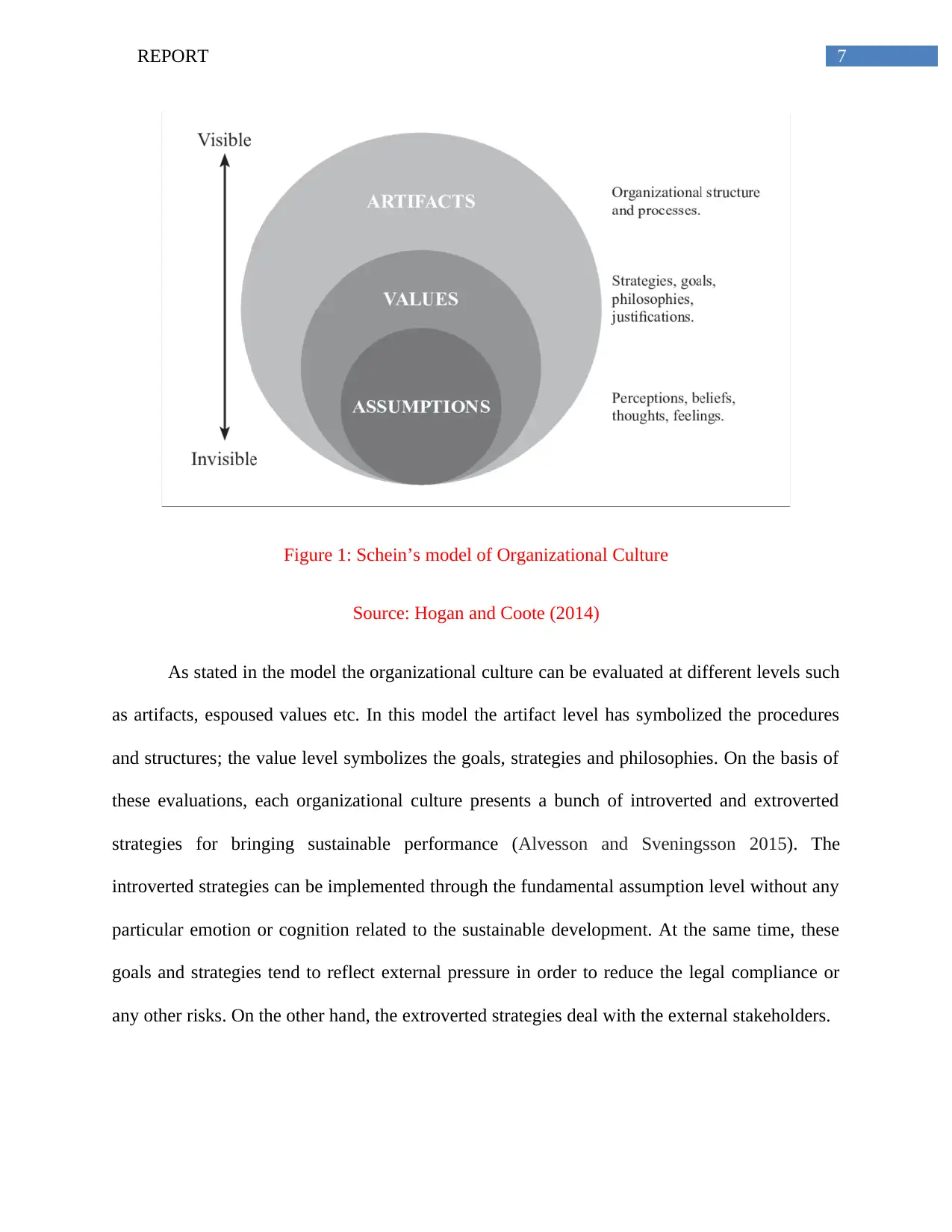
7REPORT
Figure 1: Schein’s model of Organizational Culture
Source: Hogan and Coote (2014)
As stated in the model the organizational culture can be evaluated at different levels such
as artifacts, espoused values etc. In this model the artifact level has symbolized the procedures
and structures; the value level symbolizes the goals, strategies and philosophies. On the basis of
these evaluations, each organizational culture presents a bunch of introverted and extroverted
strategies for bringing sustainable performance (Alvesson and Sveningsson 2015). The
introverted strategies can be implemented through the fundamental assumption level without any
particular emotion or cognition related to the sustainable development. At the same time, these
goals and strategies tend to reflect external pressure in order to reduce the legal compliance or
any other risks. On the other hand, the extroverted strategies deal with the external stakeholders.
Figure 1: Schein’s model of Organizational Culture
Source: Hogan and Coote (2014)
As stated in the model the organizational culture can be evaluated at different levels such
as artifacts, espoused values etc. In this model the artifact level has symbolized the procedures
and structures; the value level symbolizes the goals, strategies and philosophies. On the basis of
these evaluations, each organizational culture presents a bunch of introverted and extroverted
strategies for bringing sustainable performance (Alvesson and Sveningsson 2015). The
introverted strategies can be implemented through the fundamental assumption level without any
particular emotion or cognition related to the sustainable development. At the same time, these
goals and strategies tend to reflect external pressure in order to reduce the legal compliance or
any other risks. On the other hand, the extroverted strategies deal with the external stakeholders.
Paraphrase This Document
Need a fresh take? Get an instant paraphrase of this document with our AI Paraphraser
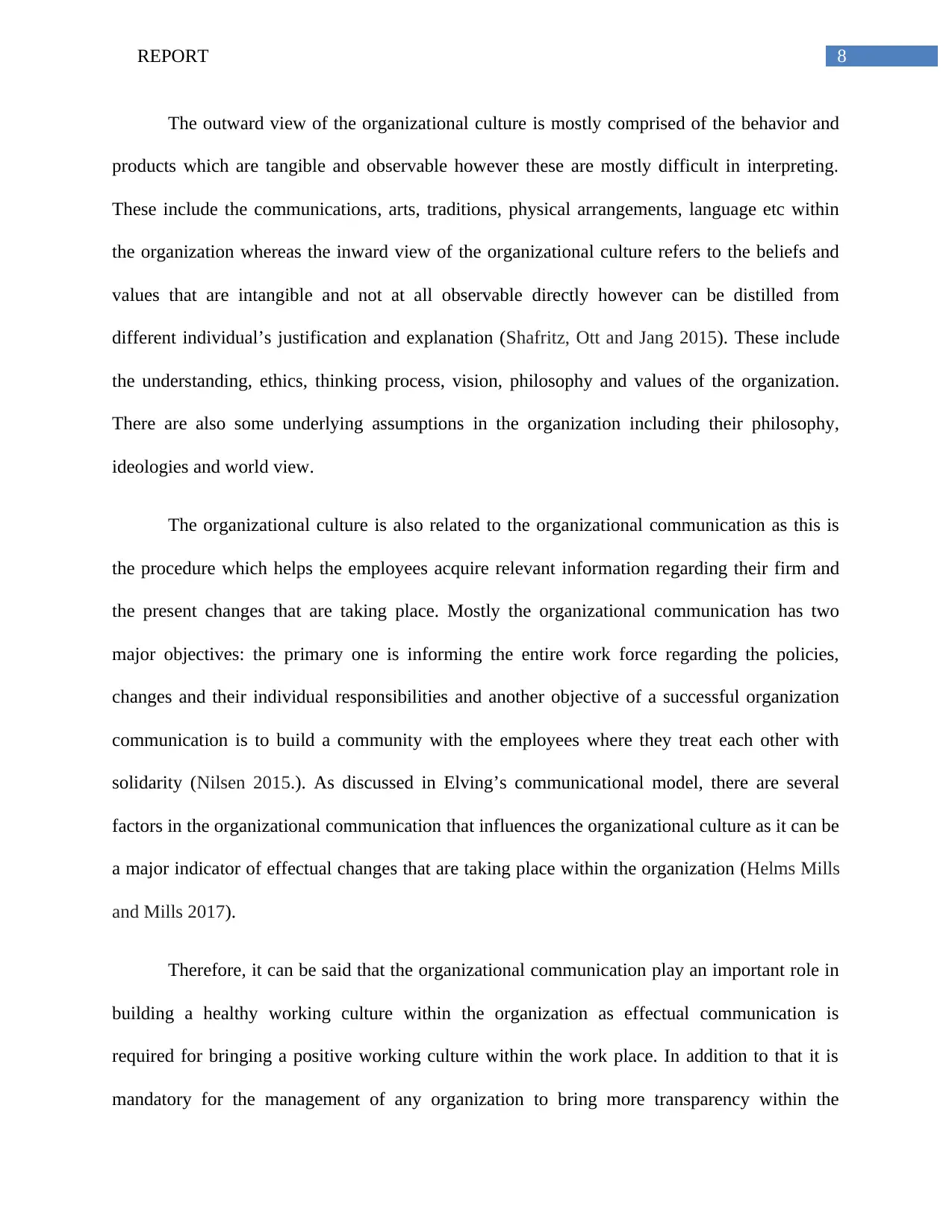
8REPORT
The outward view of the organizational culture is mostly comprised of the behavior and
products which are tangible and observable however these are mostly difficult in interpreting.
These include the communications, arts, traditions, physical arrangements, language etc within
the organization whereas the inward view of the organizational culture refers to the beliefs and
values that are intangible and not at all observable directly however can be distilled from
different individual’s justification and explanation (Shafritz, Ott and Jang 2015). These include
the understanding, ethics, thinking process, vision, philosophy and values of the organization.
There are also some underlying assumptions in the organization including their philosophy,
ideologies and world view.
The organizational culture is also related to the organizational communication as this is
the procedure which helps the employees acquire relevant information regarding their firm and
the present changes that are taking place. Mostly the organizational communication has two
major objectives: the primary one is informing the entire work force regarding the policies,
changes and their individual responsibilities and another objective of a successful organization
communication is to build a community with the employees where they treat each other with
solidarity (Nilsen 2015.). As discussed in Elving’s communicational model, there are several
factors in the organizational communication that influences the organizational culture as it can be
a major indicator of effectual changes that are taking place within the organization (Helms Mills
and Mills 2017).
Therefore, it can be said that the organizational communication play an important role in
building a healthy working culture within the organization as effectual communication is
required for bringing a positive working culture within the work place. In addition to that it is
mandatory for the management of any organization to bring more transparency within the
The outward view of the organizational culture is mostly comprised of the behavior and
products which are tangible and observable however these are mostly difficult in interpreting.
These include the communications, arts, traditions, physical arrangements, language etc within
the organization whereas the inward view of the organizational culture refers to the beliefs and
values that are intangible and not at all observable directly however can be distilled from
different individual’s justification and explanation (Shafritz, Ott and Jang 2015). These include
the understanding, ethics, thinking process, vision, philosophy and values of the organization.
There are also some underlying assumptions in the organization including their philosophy,
ideologies and world view.
The organizational culture is also related to the organizational communication as this is
the procedure which helps the employees acquire relevant information regarding their firm and
the present changes that are taking place. Mostly the organizational communication has two
major objectives: the primary one is informing the entire work force regarding the policies,
changes and their individual responsibilities and another objective of a successful organization
communication is to build a community with the employees where they treat each other with
solidarity (Nilsen 2015.). As discussed in Elving’s communicational model, there are several
factors in the organizational communication that influences the organizational culture as it can be
a major indicator of effectual changes that are taking place within the organization (Helms Mills
and Mills 2017).
Therefore, it can be said that the organizational communication play an important role in
building a healthy working culture within the organization as effectual communication is
required for bringing a positive working culture within the work place. In addition to that it is
mandatory for the management of any organization to bring more transparency within the

9REPORT
organization as it brings an improved understanding of responsibilities and a strong bonding
amongst the employees (Elsbach and Stigliani 2018).
Discussion of present situation
In the given case study, it can be observed that the organizational culture lacks positivity
and there is also an identifiable absence of morale within employees. It can be observed that
there is a major lack in the organizational communication as the management does not pass
relevant information about any taken decision to all strata of employees and does not involve any
of the employees in the decision making process. The culture of the organization is authoritative
as the higher management takes all the major decisions. The employees do not seem to have the
freedom for sharing their ideas within an open place so that the most innovative one can be
followed. In place of a collaborative discussion, the management takes the decisions on own,
therefore even the consistent performers have no right to intervene in the strategy making
process; rather they will only have to abide by the taken decisions. Without a proper flow of
communication, the employees are only dependent on their supervisors and managers; therefore
they also lack the competence of working within a global environment (Huhtala et al. 2015).
Another characteristic of the existing organizational culture is that there is a major lack of
development of the employees which also indicates that the entire organization lacks necessary
growth. Functioning in a global environment and performing sustainably requires a
organizational culture that enhances productivity and contributes towards evolving the
employees into successful managers (Kearney 2018). The existing culture of Water & Sewerage
Department does not contribute towards having effective managing capabilities of the
employees; rather they make their employees entirely dependent on their supervisors and
managers. The existing organizational culture also shows major conflict of interest between the
organization as it brings an improved understanding of responsibilities and a strong bonding
amongst the employees (Elsbach and Stigliani 2018).
Discussion of present situation
In the given case study, it can be observed that the organizational culture lacks positivity
and there is also an identifiable absence of morale within employees. It can be observed that
there is a major lack in the organizational communication as the management does not pass
relevant information about any taken decision to all strata of employees and does not involve any
of the employees in the decision making process. The culture of the organization is authoritative
as the higher management takes all the major decisions. The employees do not seem to have the
freedom for sharing their ideas within an open place so that the most innovative one can be
followed. In place of a collaborative discussion, the management takes the decisions on own,
therefore even the consistent performers have no right to intervene in the strategy making
process; rather they will only have to abide by the taken decisions. Without a proper flow of
communication, the employees are only dependent on their supervisors and managers; therefore
they also lack the competence of working within a global environment (Huhtala et al. 2015).
Another characteristic of the existing organizational culture is that there is a major lack of
development of the employees which also indicates that the entire organization lacks necessary
growth. Functioning in a global environment and performing sustainably requires a
organizational culture that enhances productivity and contributes towards evolving the
employees into successful managers (Kearney 2018). The existing culture of Water & Sewerage
Department does not contribute towards having effective managing capabilities of the
employees; rather they make their employees entirely dependent on their supervisors and
managers. The existing organizational culture also shows major conflict of interest between the
⊘ This is a preview!⊘
Do you want full access?
Subscribe today to unlock all pages.

Trusted by 1+ million students worldwide

10REPORT
management and employees. This can also be the outcome of the major lack in organizational
communication as the management does not even get to know their employees’ voice. In
addition to that the existing culture does not provide a proper training and development to the
employees, therefore with such little scope to learn employees may not be adequately competent
to work in a global sustainable environment.
Following the organizational structure, it can be said that the customer care department
has been given more importance to deal with the operational activities; therefore it can be highly
possible that the employees there, are overburdened and de-motivated. While working in a global
environment and perform sustainably, the organization needs to distribute the roles and
responsibilities equally in the departments so that there is no such overload of work (Mostafa,
Gould‐Williams and Bottomley 2015).
Issues with culture and leadership
Relevant leadership theories
Autocratic Leadership
Autocratic leadership is a style of authority described by singular control over all the
choices and little contribution from other individuals (De Hoogh, Greer and Den Hartog 2015).
Benefits of Autocratic Leadership:
Autocratic authority can be advantageous in only some occurrences, for an example,
when choices should be made speedily without counseling with an expansive assembly of
individuals. A few tasks need solid influence keeping in mind the target is to get things achieved
rapidly and effectively (Puni, Ofei and Okoe 2014). It enables individuals from the gathering to
management and employees. This can also be the outcome of the major lack in organizational
communication as the management does not even get to know their employees’ voice. In
addition to that the existing culture does not provide a proper training and development to the
employees, therefore with such little scope to learn employees may not be adequately competent
to work in a global sustainable environment.
Following the organizational structure, it can be said that the customer care department
has been given more importance to deal with the operational activities; therefore it can be highly
possible that the employees there, are overburdened and de-motivated. While working in a global
environment and perform sustainably, the organization needs to distribute the roles and
responsibilities equally in the departments so that there is no such overload of work (Mostafa,
Gould‐Williams and Bottomley 2015).
Issues with culture and leadership
Relevant leadership theories
Autocratic Leadership
Autocratic leadership is a style of authority described by singular control over all the
choices and little contribution from other individuals (De Hoogh, Greer and Den Hartog 2015).
Benefits of Autocratic Leadership:
Autocratic authority can be advantageous in only some occurrences, for an example,
when choices should be made speedily without counseling with an expansive assembly of
individuals. A few tasks need solid influence keeping in mind the target is to get things achieved
rapidly and effectively (Puni, Ofei and Okoe 2014). It enables individuals from the gathering to
Paraphrase This Document
Need a fresh take? Get an instant paraphrase of this document with our AI Paraphraser

11REPORT
center around performing specific assignments without stressing over settling on choices which
are complex in nature. This additionally permits assemble individuals to wind up exceedingly
talented at playing out specific obligations, which can be helpful to the gathering (Iqbal, Anwar
and Haider 2015).
Drawbacks of Autocratic Leadership
While absolutist administration can be valuable, there are additional abundant occasions
where this autocratic style can be risky. Individuals who manhandle an imperious authority style
are frequently seen as controlling and dominating (Puni, Ofei and Okoe 2014). Since dictatorial
leaders settle on options without counseling the gathering of related individuals, related people in
the assembly may hate the fact that they can't contribute their own thoughts and innovative ideas
(De Hoogh, Greer and Den Hartog 2015). Scientists have also discovered that dictatorial
leadership promotes lack of of inventive answers for issues that can at last affect the execution of
the assembly of the employees. While despotic initiative has some potential traps, pioneers can
figure out how to utilize components of this style astutely (Puni, Ofei and Okoe 2014).
Bureaucratic Leadership
This style of authority takes after a nearby arrangement of measures. Everything is
performed in a correct, specific approach to guarantee wellbeing or potentially exactness. It can
be regularly discovered that this dominant position in a circumstance where the workplace is
perilous and meticulous arrangements of techniques are vital to assure security (Cunningham,
Salomone and Wielgus 2015).
center around performing specific assignments without stressing over settling on choices which
are complex in nature. This additionally permits assemble individuals to wind up exceedingly
talented at playing out specific obligations, which can be helpful to the gathering (Iqbal, Anwar
and Haider 2015).
Drawbacks of Autocratic Leadership
While absolutist administration can be valuable, there are additional abundant occasions
where this autocratic style can be risky. Individuals who manhandle an imperious authority style
are frequently seen as controlling and dominating (Puni, Ofei and Okoe 2014). Since dictatorial
leaders settle on options without counseling the gathering of related individuals, related people in
the assembly may hate the fact that they can't contribute their own thoughts and innovative ideas
(De Hoogh, Greer and Den Hartog 2015). Scientists have also discovered that dictatorial
leadership promotes lack of of inventive answers for issues that can at last affect the execution of
the assembly of the employees. While despotic initiative has some potential traps, pioneers can
figure out how to utilize components of this style astutely (Puni, Ofei and Okoe 2014).
Bureaucratic Leadership
This style of authority takes after a nearby arrangement of measures. Everything is
performed in a correct, specific approach to guarantee wellbeing or potentially exactness. It can
be regularly discovered that this dominant position in a circumstance where the workplace is
perilous and meticulous arrangements of techniques are vital to assure security (Cunningham,
Salomone and Wielgus 2015).

12REPORT
Benefits of Bureaucratic Leadership:
There are numbers of benefits of applying bureaucratic leadership within the organization
as the central authority is the most important part of the firm. There is a sense of command chain
which gives different tasks and roles to different individuals in the organization. Therefore it is
easier for the management to monitor the operational activities, so the responsibilities tend to be
carried out in a timely and most importantly in a systematic way. This leadership refers to the
concept of having appointed specific individuals with relevant educational backgrounds;
therefore it enhances the competence of employees working in particular fields (Ngotngamwong
2018). Also this leadership theory leaves no room for any favoritism and it refers to a merit
based promotion as well as hiring in the organization. Model 1 of the six models of organization
refers to this classic bureaucratic leadership that is run through different structures, regulations,
controls and job descriptions. Most of the government organizations follow this kind of
leadership where the system works like a machine.
Figure 2: Model 1 of Six Models of Organization
Benefits of Bureaucratic Leadership:
There are numbers of benefits of applying bureaucratic leadership within the organization
as the central authority is the most important part of the firm. There is a sense of command chain
which gives different tasks and roles to different individuals in the organization. Therefore it is
easier for the management to monitor the operational activities, so the responsibilities tend to be
carried out in a timely and most importantly in a systematic way. This leadership refers to the
concept of having appointed specific individuals with relevant educational backgrounds;
therefore it enhances the competence of employees working in particular fields (Ngotngamwong
2018). Also this leadership theory leaves no room for any favoritism and it refers to a merit
based promotion as well as hiring in the organization. Model 1 of the six models of organization
refers to this classic bureaucratic leadership that is run through different structures, regulations,
controls and job descriptions. Most of the government organizations follow this kind of
leadership where the system works like a machine.
Figure 2: Model 1 of Six Models of Organization
⊘ This is a preview!⊘
Do you want full access?
Subscribe today to unlock all pages.

Trusted by 1+ million students worldwide
1 out of 22
Related Documents
Your All-in-One AI-Powered Toolkit for Academic Success.
+13062052269
info@desklib.com
Available 24*7 on WhatsApp / Email
![[object Object]](/_next/static/media/star-bottom.7253800d.svg)
Unlock your academic potential
Copyright © 2020–2025 A2Z Services. All Rights Reserved. Developed and managed by ZUCOL.




